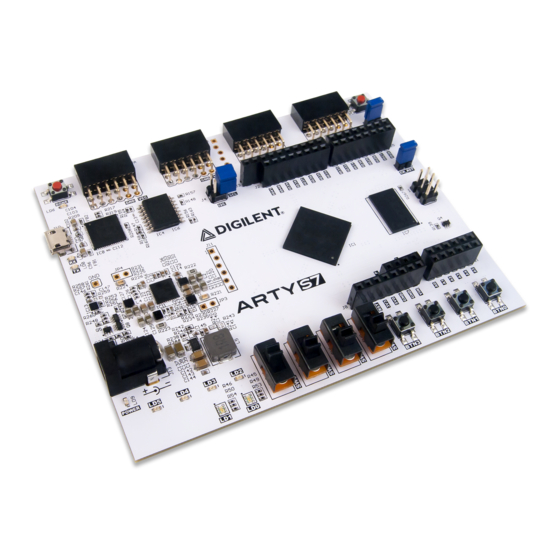Digilent Arty S7 Справочное руководство - Страница 5
Просмотреть онлайн или скачать pdf Справочное руководство для Материнская плата Digilent Arty S7. Digilent Arty S7 14 страниц.

(https://reference.digilentinc.com/_detail/reference/programmable-logic/arty-s7/labelled_photo.png?id=reference%3Aprogrammable-logic%3Aarty-s7%3Areference-manual)
Callout
Description
1
FPGA programming DONE LED ()
2
Shared USB JTAG / UART port
3
Power select jumper (Ext. supply / USB)
4
Power jack (for optional ext. supply)
5
Power good LED ()
6
User LEDs
7
User Tri color LEDs
8
User slide switches
9
User push buttons
10
Arduino/ChipKIT shield connectors
Purchasing Options
The board is sold standalone, but requires either a micro USB cable or 7-15V external power supply to be powered. The external power supply must have a coaxial, center-positive
connector with 2.1 mm or 2.5 mm internal diameter. When purchased from Digilent, a micro USB cable or suitable 12V, 3A power supply can added at the time of purchase.
You may see the Arty S7 referred to as the Arty S7-50 throughout some Digilent documentation. This is to distinguish it from future variants of the Arty S7 that will be loaded with
different versions of the Spartan-7. These variants are not available yet.
Software Support
The Arty S7 is fully compatible with the high-performance Vivado ® Design Suite. It is supported under the free WebPACK™ license, so designs can be implemented at no additional
cost. This free license includes the ability to create MicroBlaze™ soft-core processor designs, the Logic Analyzer, and High-level Synthesis (HLS). The Logic Analyzer assists with
debugging logic, and the HLS tool allows you to compile C code directly into HDL. Design resources, example projects, and tutorials are available for download at the Arty S7
Resource Center
(https://reference.digilentinc.com/reference/programmable-logic/arty-s7/start)
Designing with Microblaze
(https://reference.digilentinc.com/_detail/arty/arty_vivadoipi.png?id=reference%3Aprogrammable-logic%3Aarty-s7%3Areference-manual)
their many features, FPGAs have the ability to transform into a custom software-defined System-on-a-Chip (SoC). These "Soft SoC" FPGA configurations are designed graphically
using a tool called Vivado IP Integrator (Vivado IPI). In this tool, pre-built peripheral blocks are dragged from an extensive library and dropped into your processing system as you see
fit. These pre-built peripherals include timers, UART/SPI/IIC controllers, and many of the other devices you would typically find in an SoC or microcontroller. Ambitious users will
also find that they can create their own peripheral blocks by writing them in a Hardware Definition Language (HDL), specifically Verilog or VHDL. For those with no interest in
learning HDL, the Xilinx High Level Synthesis tool can be used to define custom peripheral blocks by writing them in C.
The Arty S7's Soft SoC configurations are powered by MicroBlaze processor cores. MicroBlaze is a 32-bit RISC soft processor core, designed specifically to be used in Xilinx FPGAs.
The MicroBlaze processor in an Arty S7 SoC configuration is typically run at 100 MHz (), though it is possible to design your SoC so that it can operate at over 200MHz. The Arty S7
supports large MicroBlaze programs with demanding memory requirements by providing 16MB of non-volatile program memory and 256MB of DDR3L RAM ().
Callout
Description
11
SPI header (Arduino/ChipKIT compatible)
12
Arduino IDE reset jumper
13
FPGA programming mode (JTAG/ Flash)
14
Processor reset
15
Pmod headers
16
FPGA programming reset button
17
SPI Flash
18
Spartan-7 FPGA
19
DDR3L memory
20
Analog devices ADP 5052 power supply
.
What makes the Arty S7 so flexible is its FPGA. Among
